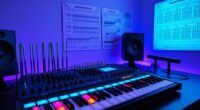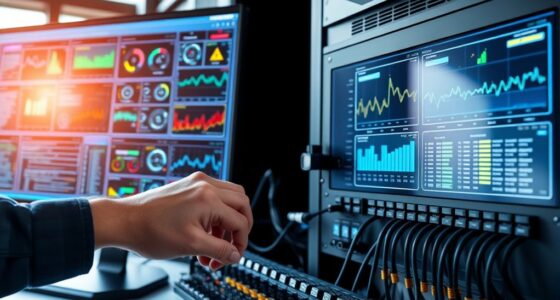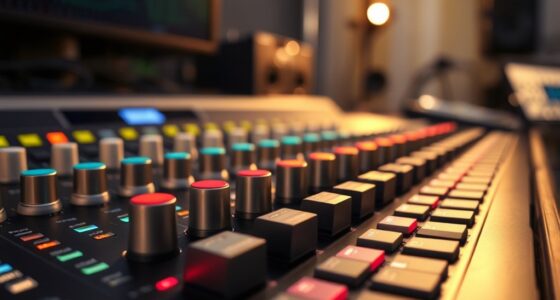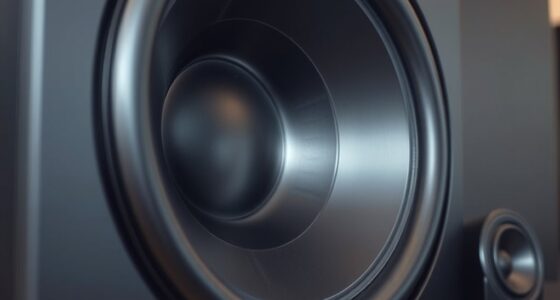Automation is your best choice when you need precise, repeatable adjustments for complex or busy mixes, ensuring consistency and accuracy. On the other hand, manually riding faders adds a human touch, giving your sound warmth, expression, and organic nuance that automation can’t replicate. Knowing when to rely on each method can elevate your mixes—keep going to discover how to blend both for the best results.
Key Takeaways
- Use automation for precise, repetitive, and complex adjustments across multiple elements and dynamic ranges.
- Employ fader riding for spontaneous, expressive nuances and real-time responses to musical performance.
- Automation ensures consistency and accuracy, reducing human error in detailed editing.
- Fader riding adds organic feel, emotional depth, and character through subtle, physical control.
- Optimal results often involve blending automation for precision and fader riding for expressiveness.
The Precision Advantage of Automation
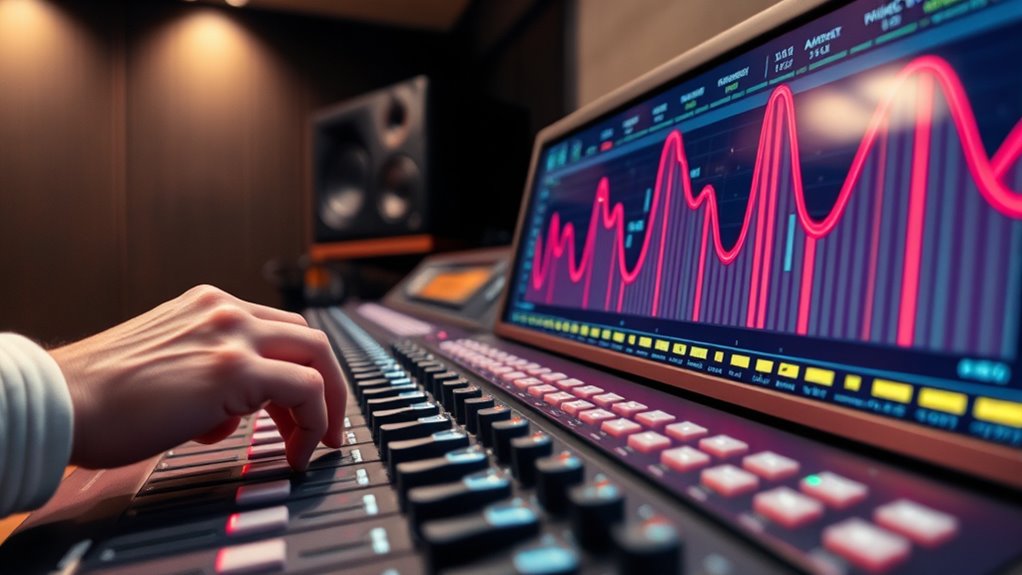
Automation offers a significant edge when it comes to precision in audio mixing. It allows you to make exact adjustments that stay consistent throughout the track, eliminating human error. Unlike manual fader riding, automation ensures your levels change smoothly and accurately at the precise moments needed. However, hardware limitations can sometimes impact the effectiveness of automation, causing it to lag or behave unexpectedly. Automation glitches—such as missed changes or erratic jumps—can disrupt the mix’s accuracy. Despite these potential issues, automation still provides unmatched control, especially for complex edits or detailed adjustments. When used correctly, it enhances your ability to achieve a polished, professional sound with precise timing and volume changes that manual riding might struggle to replicate consistently. Additionally, understanding Jeep Tuning can inspire innovative approaches to refining your vehicle’s performance, much like fine-tuning an audio mix.
Expressiveness Through Manual Fader Riding

Manual fader riding offers a level of expressiveness that automation often struggles to replicate, allowing you to inject human emotion and nuance into your mix. By adjusting faders in real-time, you capture subtle expressive nuances that convey mood and dynamics more naturally. This manual finesse lets you respond instantly to the music’s feel, creating a lively, organic sound. Use the table below to see how different approaches influence your mix:
| Technique | Impact |
|---|---|
| Manual Fader Riding | Adds expressive nuances, organic feel, human touch |
| Automation | Precise, consistent, ideal for complex adjustments |
Choosing manual fader riding enhances spontaneity, making your mix more emotionally engaging and alive. Additionally, understanding the financial impact of entertainment industries like WWE Raw and the earnings of top female singers can inspire more dynamic and expressive mixing techniques.
When to Choose Automation for Complex Mixes

When your mix involves a wide dynamic range or multiple elements that need precise control, automation becomes essential. It helps you manage levels consistently and shape the sound with accuracy. If manual fader riding feels overwhelming or inconsistent, automation is the smarter choice for complex mixes. Additionally, implementing wealth management strategies can optimize your overall mixing process and ensure long-term success.
Handling Dynamic Range
Handling dynamic range becomes essential in complex mixes where multiple elements compete for attention. Automation is your best tool when you need precise control over volume fluctuations, especially for dynamic compression. It allows you to shape the stereo imaging by subtly adjusting panning and levels throughout the track, ensuring clarity and balance. When certain instruments or vocals vary markedly in energy, automation helps maintain consistent presence without sacrificing natural dynamics. Relying solely on riding faders can be exhausting and less precise for complex changes. By automating, you can smoothly enhance or tame peaks, improve stereo width, and craft a polished, professional sound. Use automation strategically to manage the intricacies of dynamic range in busy mixes, where manual adjustments fall short. Additionally, leveraging digital sound synthesis can help craft unique effects that complement your automation strategies.
Managing Multiple Elements
In complex mixes featuring numerous elements competing for attention, automation becomes essential for managing their interactions effectively. It allows you to precisely control multiple tracks’ levels, panning, and effects over time, especially during dynamic sections. When deciding whether to automate or ride the faders, consider these factors:
- Genre specific techniques—electronic music might rely heavily on automation for evolving textures.
- Hardware versus software—software automation offers detailed, recallable adjustments, while hardware can provide tactile control.
- Complexity—more elements often require automation for consistency.
- Precision—automation ensures exact timing and level changes that are hard to achieve manually.
- Incorporating original decor elements like vintage furniture and rustic lighting can help create a cohesive visual theme that complements your mix choices.
Using automation in complex mixes streamlines workflow, maintains clarity, and adapts seamlessly to changing musical landscapes.
Ensuring Consistent Levels
Achieving consistent levels throughout a complex mix can be challenging, especially when multiple elements fluctuate dynamically. Automation excels here, allowing precise control beyond hardware limitations and reducing the risk of automation glitches. When your mix demands smooth, detailed adjustments, automation ensures each element stays balanced, even in complex sections. Additionally, using automation can help prevent mixing errors that often occur with manual fader riding.
The Organic Feel of Hand-Performed Fader Movements
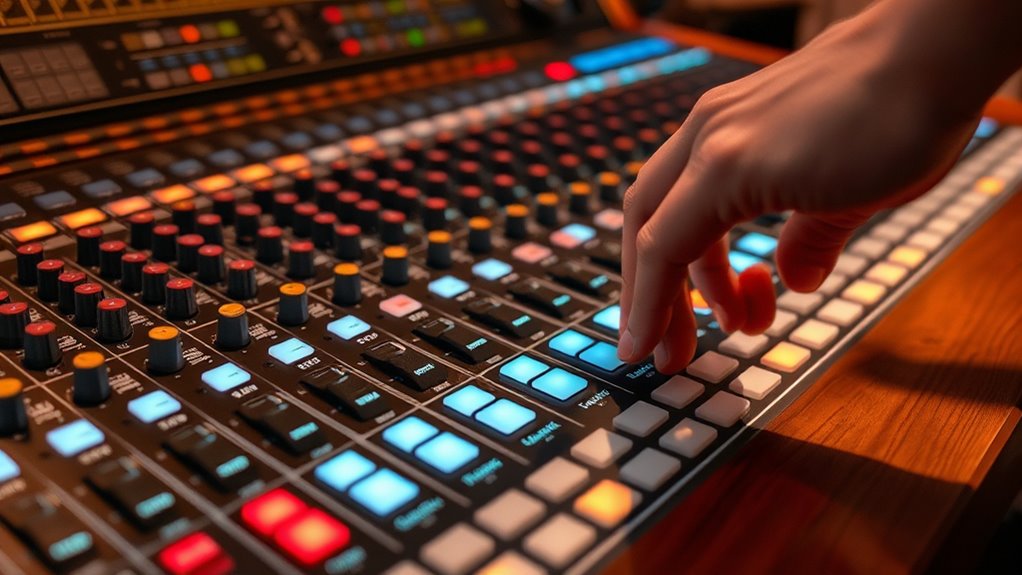
When you manually move faders, you introduce subtle variations and nuances that automated systems often miss. This tactile feedback allows you to feel the music’s dynamics and respond instinctively. It creates an organic feel that’s hard to replicate with automation. Consider these benefits:
- You can effortlessly add musical nuance with slight adjustments.
- Your fingers sense the fader position, making precise control easier.
- Small, intentional movements add emotion and character.
- The physicality connects you more deeply to the music, fostering creativity.
- Engaging actively with your controls promotes active listening and a deeper understanding of the music’s nuances.
This hands-on approach captures the human touch, resulting in a more lively, expressive mix. The organic feel of fader riding stems from your ability to respond in real-time, making each performance uniquely yours.
Combining Automation and Fader Riding for Dynamic Results

By blending automation with fader riding, you can achieve a balance between precision and expressiveness in your mix. Timing each approach carefully lets you maintain creative control while adding dynamic movement. This combination offers the flexibility to craft results that are both polished and lively. Incorporating privacy and consent management considerations ensures that your workflow remains compliant while respecting user preferences.
Balancing Precision and Expressiveness
Combining automation and fader riding allows you to create mixes that are both precise and emotionally engaging. To balance these approaches, you need to contemplate hardware limitations and software compatibility. Here are key points:
- Use automation for detailed, consistent adjustments, especially where hardware limitations make real-time riding difficult.
- Reserve fader riding for spontaneous, expressive moments when you want a human touch.
- Check your DAW’s software compatibility—some platforms handle automation and riding differently, affecting your workflow.
- Remember, blending both methods helps achieve dynamic mixes, but overusing automation can make your mix robotic, while relying solely on riding might lack precision.
- Understanding mixing techniques can further refine how you combine automation and fader riding for optimal results.
Striking the right balance lets you craft mixes that are accurate yet lively, capturing both technical finesse and emotion.
Timing Automation and Riding
Timing automation and fader riding work best when used together to create dynamic, expressive mixes. You can automate precise timing adjustments for effects or volume changes, then fine-tune those movements by riding the fader in real-time. Using a quality hardware interface minimizes automation latency, ensuring your manual adjustments stay in sync with automated parts. This combo allows you to capture the best of both worlds: the consistency of automation and the organic feel of riding the fader. When you understand how to blend these techniques, your mix gains depth and fluidity that neither method alone can achieve. Just be mindful of automation latency; if it’s too high, your manual riding may feel disconnected or delayed, undermining your effort to create lively, well-timed dynamics. Incorporating sleep and mental health practices such as mindfulness can also enhance your focus and precision during mixing.
Creative Control and Flexibility
When you use automation alongside fader riding, you open a higher level of creative control and flexibility in your mix. This combo enhances your ability to shape sound dynamically and vividly.
- You can craft visual creativity by precisely timing volume changes, making your mix more engaging to view and hear.
- Emotional expression becomes more powerful as you highlight or subdue elements to evoke specific feelings.
- Automation allows for subtle, precise adjustments that complement the spontaneous feel of fader riding.
- Combining both methods lets you experiment freely, blending organic performance with engineered finesse.
This synergy ensures your mix can adapt seamlessly, delivering a more compelling, emotionally resonant experience for your audience.
Limitations of Automated Mixing Techniques

Although automated mixing tools have advanced considerably, they still face notable limitations. Hardware limitations can cause processing delays or glitches, especially with complex projects or less powerful systems. These technical constraints can lead to automation inaccuracies, where adjustments may not perfectly match the desired sound. Automated algorithms often struggle to interpret nuanced musical elements, missing subtle dynamics or emotional cues that a human mixer would catch. Additionally, these tools lack the contextual awareness that guides a seasoned engineer’s decisions, making them less adaptable in unpredictable situations. As a result, relying solely on automation can produce mixes that feel rigid or unnatural. While automation excels at repetitive tasks, it can’t fully replicate the intuition and creative judgment that come from hands-on control.
The Tactile Control of Manual Fader Adjustments

Manual fader adjustments provide a tactile connection that automation can’t replicate, allowing you to feel and respond to the nuances of the mix in real-time. This tactile feedback gives you a sense of control and precision, enhancing your manual finesse. When using faders, you can:
- Instantly respond to unexpected issues or changes during a session.
- Fine-tune levels with subtle, intuitive movements.
- Gauge your adjustments through physical sensation, not just visual cues.
- Develop a muscle memory that speeds up your workflow.
This direct control helps you stay connected to the music, making adjustments more natural and expressive. The physical act of riding the faders keeps you engaged, giving you an edge in crafting a well-balanced, dynamic mix.
Best Practices for Integrating Both Methods
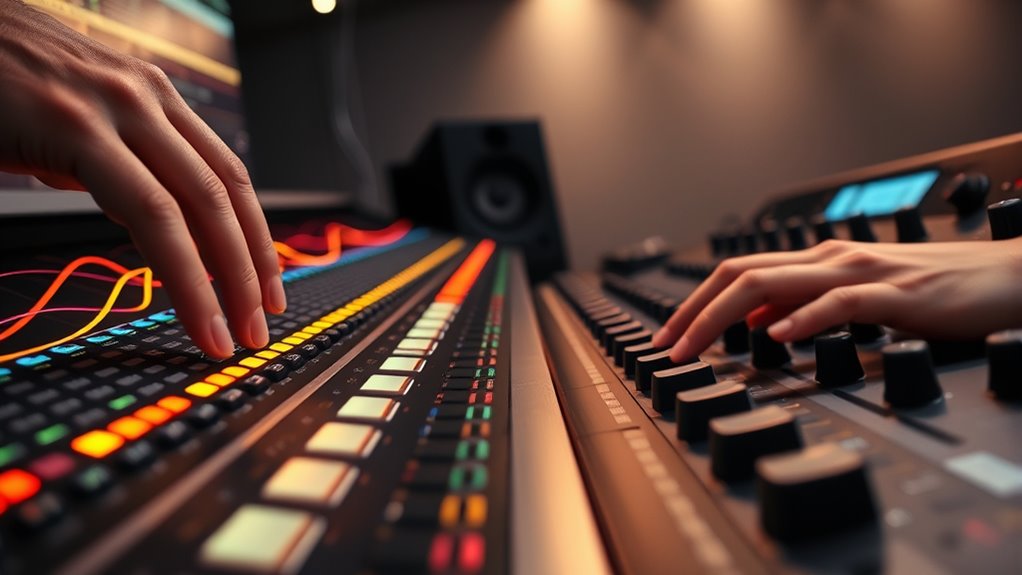
To get the most out of your mixing, you need to find the right balance between automation and riding the faders. Think about how each method fits into your workflow and when to switch between them for efficiency. By strategically integrating both, you can maintain control while leveraging automation’s precision.
Balancing Automation and Faders
Finding the right balance between automation and fader riding is essential for achieving a polished mix. To maximize automation efficiency while showcasing your fader artistry, consider these tips:
- Use automation for predictable, repetitive adjustments, saving time and maintaining consistency.
- Reserve fader riding for nuanced, expressive changes that bring life to the mix.
- Automate large shifts early, then fine-tune with faders during critical moments.
- Regularly review your automation to ensure it complements your fader work, not overrides it.
Strategic Workflow Integration
Integrating automation and fader riding into your workflow requires deliberate planning to guarantee they complement each other seamlessly. First, assess your hardware limitations to confirm your setup can handle both methods without bottlenecks or latency issues. Next, verify software compatibility; some DAWs or plugins might favor automation over manual control or vice versa. Establish a clear signal flow, assigning specific tasks to each method—use automation for precise, repeatable changes, and ride faders for real-time adjustments during mixing. Maintain organized session templates to streamline progressions between methods. Regularly update your hardware drivers and software to prevent compatibility issues. By thoughtfully combining these approaches, you optimize your workflow, assuring that each method enhances the other and achieves professional results efficiently.
Case Studies: Automation in Electronic Music
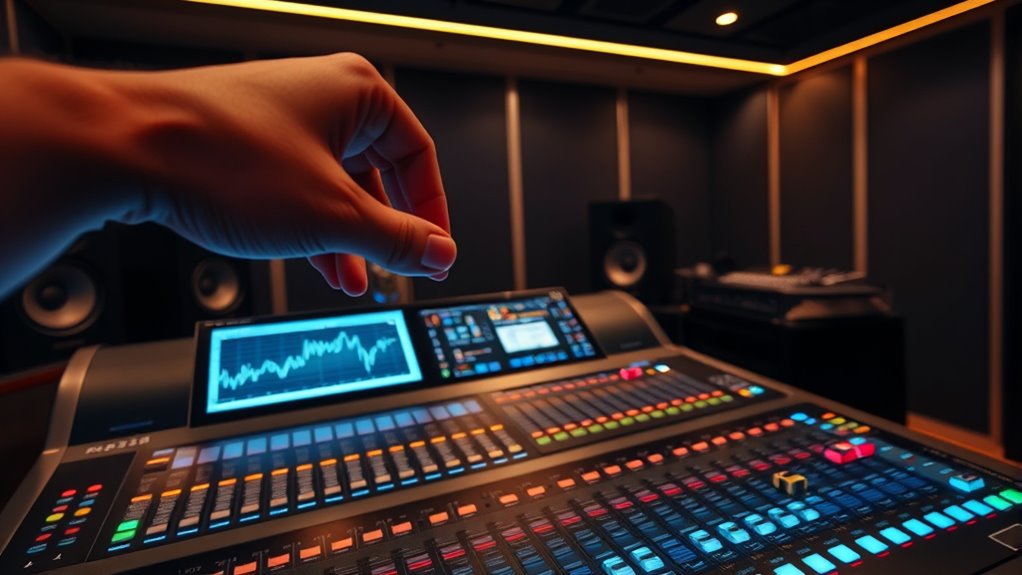
Automation has become a vital tool in shaping the dynamic textures of electronic music, allowing you to craft evolving soundscapes that captivate listeners. By integrating automation with hardware, you can achieve seamless control over effects and parameters. Here are some case study insights:
Automation transforms electronic music with dynamic textures and seamless hardware control.
- Using automation for precise filter sweeps that respond to real-time control, creating movement without manual fader riding.
- Programming automation to synchronize with MIDI hardware, enhancing live performance flexibility.
- Applying automation to modulate effects over time, adding complexity to static sounds.
- Leveraging advanced automation curves to develop evolving textures that would be difficult to perform manually.
These examples show how automation elevates electronic music production, especially through hardware integration and real-time control, making sounds more dynamic and expressive.
Case Studies: Fader Riding in Live Recordings

Fader riding in live recordings brings spontaneity and expressiveness that automation often can’t replicate in real time. You feel the raw energy, capturing moments of musical emotion with each move. Analog warmth from vintage hardware limitations adds a soulful depth, making every subtle shift resonate more deeply. This method is ideal when capturing the authentic vibe of a performance, where human touch shines through.
| Live Performance | Emotional Impact |
|---|---|
| Spontaneous Fader Adjustments | Genuine, unfiltered expression |
| Hardware Limitations | Adds character and warmth |
| Real-Time Intervention | Captures raw, authentic moments |
| Less Precision | Embraces imperfection for soul |
| Unique Dynamics | No two takes are identical |
Frequently Asked Questions
How Do Automation and Fader Riding Impact Mixing Workflow Efficiency?
You can improve your mixing workflow efficiency by understanding how automation and fader riding influence dynamic control and timing precision. Automation allows precise adjustments over time, saving you from manual tweaks and ensuring consistency. Fader riding offers real-time control, giving you immediate feedback and flexibility during critical moments. Using both strategically helps you balance efficiency with artistic expression, streamlining your process while maintaining high-quality, nuanced mixes.
What Equipment Is Essential for Effective Manual Fader Riding?
You’re in the hot seat when manual fader riding, so having the right gear is vital. Start with quality hardware essentials like smooth, responsive faders and reliable controllers. An ergonomic setup—adjustable stands, comfortable seating—keeps you focused and prevents fatigue. With these tools, you can ride the faders like a pro, making real-time adjustments that add life to your mix. It’s all about having your ducks in a row for seamless control.
Can Automation Replicate the Nuances of Live Fader Movements?
Automation can mimic some aspects of live fader movements, but it often falls short of capturing the expressive control and dynamic nuance you get from riding the faders manually. You lose that human touch, which adds emotional depth and spontaneity to a mix. While automation helps with precision and consistency, it can’t fully replicate the subtle variations and real-time responsiveness that a skilled engineer brings through live fader riding.
How Does Genre Influence the Choice Between Automation and Fader Riding?
Imagine you’re mixing a jazz track with subtle dynamics. Genre-specific automation helps you precisely control these nuances, ensuring consistency. In contrast, fader riding offers adaptability for genres like rock, where live energy and spontaneous adjustments matter. Your choice depends on the genre: automation provides precision for genres needing consistency, while fader riding allows flexibility for styles emphasizing organic performance. Both methods serve different musical needs effectively.
Are There Hybrid Techniques That Combine Both Methods Seamlessly?
You can achieve dynamic blending by combining hybrid automation techniques seamlessly. Use automation to set precise levels for static parts, then ride the faders for expressive, real-time adjustments during performance. This hybrid approach allows you to harness the strengths of both methods, ensuring smooth progression while maintaining spontaneity. By integrating hybrid automation into your workflow, you gain control and flexibility, making your mix more engaging and professionally polished.
Conclusion
Ultimately, choosing between automation and fader riding depends on your project’s needs. Automation offers precision, but riding the faders by hand adds a human touch that can breathe life into your mix. Sometimes, it’s best to have your cake and eat it too—blend both methods for a dynamic, expressive result. Trust your instincts, experiment, and remember, the best mix is the one that sounds right to you.


